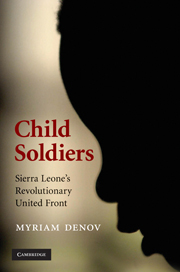Book contents
- Frontmatter
- Contents
- Acknowledgements
- Map
- Introduction: Child soldiers, iconography and the (il)logic of extremes
- 1 Children's involvement in war: The quandary of structure and agency
- 2 Recipe for rebellion: Civil war in Sierra Leone
- 3 Negotiating power: Research on and by child soldiers
- 4 ‘Becoming RUF’: The making of a child soldier
- 5 ‘Being RUF’: Victimization, participation and resistance
- 6 ‘Put dey gon don’: The unmaking of a child soldier
- 7 New battlefields
- References
- Index
2 - Recipe for rebellion: Civil war in Sierra Leone
Published online by Cambridge University Press: 04 May 2010
- Frontmatter
- Contents
- Acknowledgements
- Map
- Introduction: Child soldiers, iconography and the (il)logic of extremes
- 1 Children's involvement in war: The quandary of structure and agency
- 2 Recipe for rebellion: Civil war in Sierra Leone
- 3 Negotiating power: Research on and by child soldiers
- 4 ‘Becoming RUF’: The making of a child soldier
- 5 ‘Being RUF’: Victimization, participation and resistance
- 6 ‘Put dey gon don’: The unmaking of a child soldier
- 7 New battlefields
- References
- Index
Summary
Where are our diamonds, Mr. President?
Where is our gold, NPRC?
RUF is hungry to know where they are
RUF is fighting to save Sierra Leone
RUF is fighting to save our people
RUF is fighting to save our country
Go and tell the President, Sierra Leone is my home
Go and tell my parents, they may see me no more
When fighting in the battlefield I'm fighting forever
Every Sierra Leonean is fighting for his land …
RUF is the saviour we need right now.
(Excerpt from ‘RUF Anthem’, Footpaths to Democracy: Toward a New Sierra Leone 1995)A small country on the West African seaboard, Sierra Leone has a population of 4.9 million with 42% of the population under the age of 15 years and 34% between the ages of 15 and 35 years (Statistics Sierra Leone 2005). Sierra Leone is composed of a multitude of African ethnic groups, all of disparate origins and practices. These include the Fullah, Gola, Kissi, Kono, Koranko, Krim, Krio, Limba, Loko, Mandingo, Mende, Sherbro, Susu, Temne, Vai and Yalunka. The two largest ethnic groups – the Mende, largely found in the south, and the Temne, largely in the north – make up an estimated 60% of the population. The Krio, who are the descendants of freed slaves, were settled in the area of Freetown in the late eighteenth century and make up 10% of the total population.
- Type
- Chapter
- Information
- Child SoldiersSierra Leone's Revolutionary United Front, pp. 48 - 79Publisher: Cambridge University PressPrint publication year: 2010



